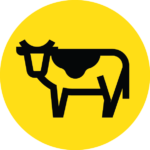
Cattle Track and Trace with Continuous Monitoring
Our mist® mesh cattle tag technology provides farmers and ranchers an efficient, effective, and low-cost capability for tracking and tracing cattle and other livestock. With our ultra-low power/long-range mist® technology, cattle can be monitored from miles away without expensive infrastructure or manual effort – freeing farmers and ranchers to focus on other tasks while having the assurance of knowing the status (location, health, and condition) of each animal in the herd. No special handheld scanning devices are needed, nor do the cattle have to be rounded up or run through a chute or pen as is required to wand and read traditional radio frequency (RF) tags.
PUTTING CATTLE MIST® TO WORK
Throughout much of 2020, we used the mist® cattle ear tag technology on a 1,500-acre Black Angus farm at the foot of the Blue Ridge Mountains in the Virginia countryside. Working closely with the farm owner and staff, we:
» Applied mist® ear tags to 38 heifers,
» Set up several long-range mist® beacons in strategic locations on the farm,
» Used a central gateway to collect data from the beacons and each cow, and
» Transmitted the data to a server for analysis and reporting.

Several of the heifers equipped with their new mist® cattle ear tags.
All data collection was accomplished without cell, GPS/satellite, or Wi-Fi communications, nor any manual effort. Easy-to-read data can be provided to the farm staff – through a cell phone, tablet, or computer – to provide real-time statuses and alerts in the event there is an issue or sensor event involving one or more cattle.

The results exceeded expectations.
We were able to confirm the health and location of all heifers continuously with no human intervention, and without the use of GPS.
EXCEEDING EXPECTATIONS
While a GPS sensor can easily be added to the mist® tag, these sensors shorten battery life and significantly increase cost. Instead, low-cost mist® beacons can confirm the cow is still in the pasture or near other key locations of importance to the farmer or rancher. We were able to confirm the health and location of all 38 heifers 24 hours per day with no human intervention and without the use of GPS. The key feature of mist® mesh is that distances are no longer a concern. Each beacon can carry mist® data well over a mile or, as required, multiple miles using our mist® repeaters. Further, our patented mist® protocol allows the tags to continuously reform, thereby preserving power and permitting the mist® mesh network to eliminate signal loss due to line-of-sight obstructions.
SMARTER FARMING
Confirming the presence of each cow on a continuous basis provides several key advantages. First, the farmer or rancher can prove that their livestock were raised exclusively on the farm, providing the hard data to help certify that each is natural or organic and thereby increasing its value. Further, mist® data supports compliance with emerging USDA Track and Trace mandates without ever having to wand an RFID tag. Mist® can also be configured to identify if livestock gets outside a fence line.
Another key mist® capability was demonstrated by installing a short-range beacon on the water trough used by the heifers. We were able to monitor the frequency and duration of each heifer’s trough visits. The farmer especially liked this capability as a general indication of the cow’s health. While mortality is less frequent on smaller eastern farms, the issue is often a serious concern on large ranches in the western United States. Tracking cattle movements and drinking patterns can help farmers, ranchers, and veterinarians identify sick individuals in time to take preventive measures.
Lastly, by including a temperature sensor in the mist® tag, a cow’s body temperature can be easily monitored and deliver near real-time readings to the farmer, rancher, or veterinarian. While we did not test for temperature in this demonstration, identifying exactly when a cow is in heat can improve conception percentages or benefit breeders that use artificial insemination. Alternatively, temperatures can also alert the farmer, rancher, or breeder of a cow that has has not been successfully bred, as well as if an individual is sick and in need of medical attention.
